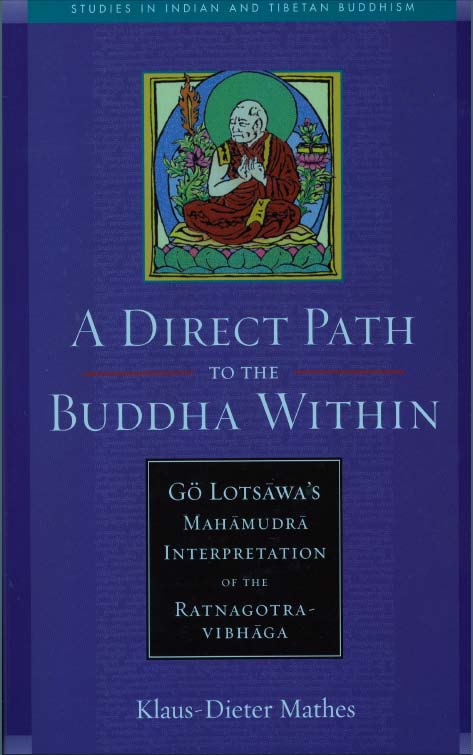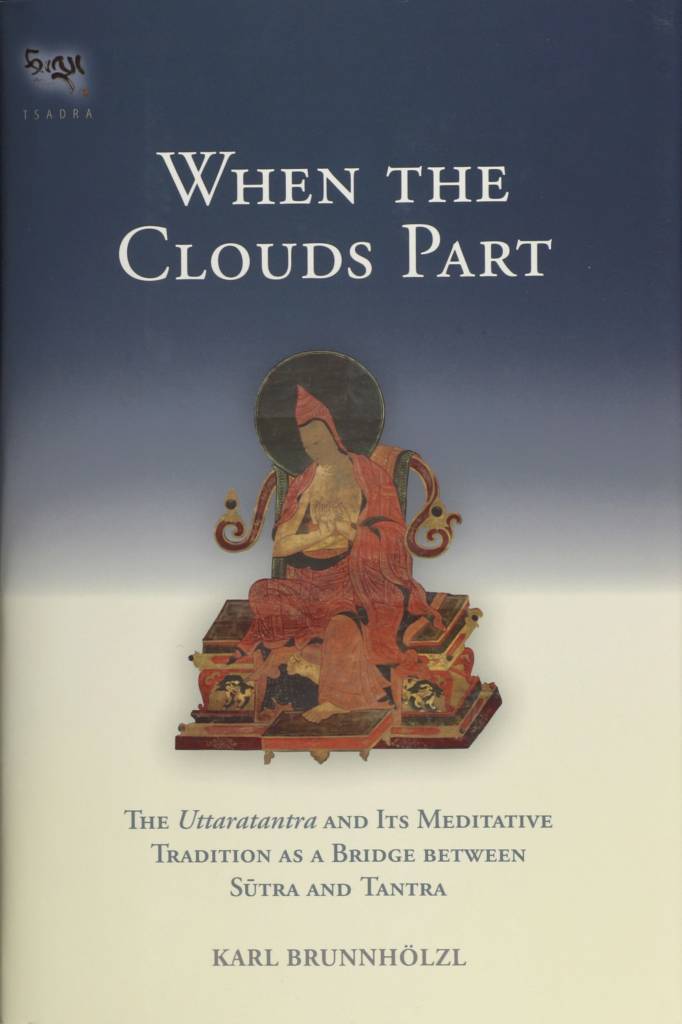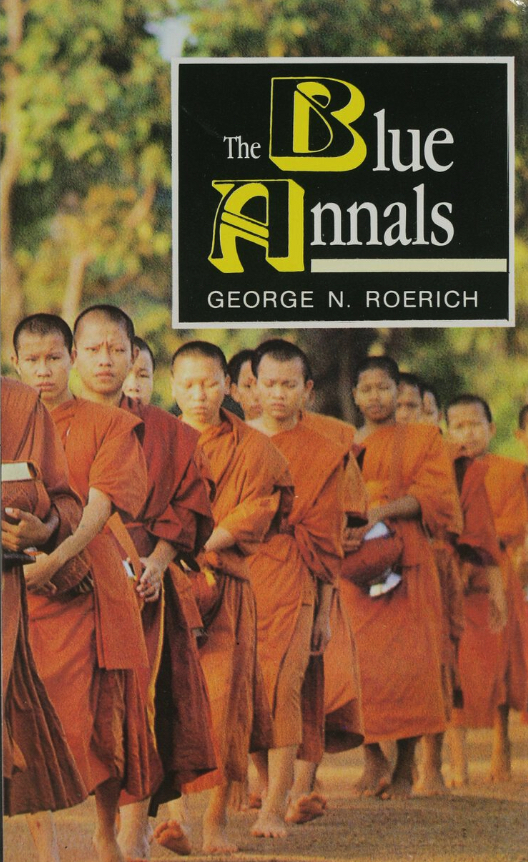Difference between revisions of "The Traditions of Ngok and Tsen"
| Line 173: | Line 173: | ||
{{BookExceprt | {{BookExceprt | ||
| − | + | |title=Book: The Blue Annals Parts I & II | |
| − | + | |cover=File:The Blue Annals-cover.jpg | |
| − | + | |coverLink=https://www.amazon.com/Blue-Annals-Pt-George-Roerich/dp/8120804716 | |
| − | + | |text=bTsan Kha-bo-che has been a disciple of Grwa-pa mNgon-śes (here mkhan-bu means | |
| − | + | a disciple ordained by Grwa-pa mNgon-śes). Before going to Kāśmīra, he requested his upādhyāya (Grwa-pa mNgon-śes) to perform an offering ceremony. The upādhyāya said to him : 'Till your return from Kāśmīra, I shall be responsible for your safety, and you will never get even a toothache!" bTsan Kha-bo-che was born in the Iron-Female-Hen year (lcags-mo-bya -I021 A.D.). At the age of 56 he proceeded to Kāśmīra, and said to Sañjana: "Now I have grown old! | |
| − | + | I cannot master many books. I wish to make the Doctrine of the Blessed Maitreya my death prayer ('chi-chos-byed-pa, to recite a religious text at death time). Pray Instruct me in it!" | |
| + | |||
| + | <div class="text-right zoom-90"> | ||
| + | {{RelatedButton | ||
| + | |link=http://buddhanature.tsadra.org/index.php/Books/The_Blue_Annals_Parts_I_%26_II/G%C3%B6_Lots%C4%81wa_on_the_Tsen_Tradition_of_the_Dharma_Treatises_of_Maitreya | ||
| + | |image=http://commons.tsadra.org/images-commons/e/e1/Go_Lotsawa_Shonnu_Pal.jpg | ||
| + | |text=Gö Lotsāwa on the Tsen Tradition of the Dharma Treatises of Maitreya | ||
| + | |label=continue reading | ||
| + | |label-right=<i class="ml-1 fal fa-arrow-up rotate45"></i> | ||
| + | |target=_blank | ||
| + | |wrapperclasses=mt-2 mb-3 | ||
| + | }} | ||
| + | </div> | ||
| + | |||
| + | |source=Roerich, George N. and Gendün Chöpel. The Blue Annals Parts I & II. Delhi: Motilal Banarsidass Publishers, 2007: pp. 475-350. | ||
| + | }} | ||
{{BookExceprt | {{BookExceprt | ||
Revision as of 16:33, 29 January 2020
Watch & Learn
From the Masters
Ngok Lotsāwa Loden Sherab
In his Epistle: a Drop of Nectar, Ngok Lotsāwa writes the following verse utilizing similes to depict a model of the path:
- །བཤེས་གཉེན་སྤྲིན་ལས་ལེགས་བྱུང་མང་དུ་ཐོས་པ་ཡི།
།ཆར་རྒྱུན་བསིལ་བས་ཉོན་མོངས་གདུང་བ་ཞི་བྱེད་ཀྱིས།
།བདེ་གཤེགས་སྙིང་པོའི་ས་བོན་རབ་ཏུ་བརླན་བྱས་ནས།
།སངས་རྒྱས་ཡོན་ཏན་ཕུན་ཚོགས་ལོ་ཏོག་རབ་རྒྱས་བྱ༎- After allaying the "heat" of defilements, with the "cool rainwater" of repeated study, carried by the "clouds" of good teachers; and after moistening the "seeds" of Buddha-nature (bde gshegs snying po), you should cultivate "crops" of perfect Buddha-qualities.
~ rngog lo tsA ba blo ldan shes rab. springs yig bdud rtsi’i thig le. In rngog lo tsA ba blo ldan shes rab kyi gsung chos skor. Beijing: Krung go'i bod rig pa dpe skrun khang, 2009: p. 659.
-Translation from Kano, Kazuo. Buddha-Nature and Emptiness: rNgog Blo-ldan-shes-rab and A Transmission of the Ratnagotravibhāga from India to Tibet. Wiener Studien zur Tibetologie und Buddhismuskunde 91. Vienna: Arbeitskreis für Tibetische und Buddhistische Studien Universität Wien, 2016: p. 232.
In the opening of his Condensed Meaning of the Mahāyāna Uttaratantra, Ngok states that the Ratnagotravibhāga is a treatise which explicates the sūtras of definitive meaning that belong to the third turning of the Dharma Wheel, and supports the doctrine of the single vehicle :
- །བཅོམ་ལྡན་འདས་བྱམས་པས་བདེ་བར་གཤེགས་པའི་བཀའི་དགོངས་པ་ཕྱིན་ཅི་མ་ལོག་པར་གསལ་བར་མཛད་པ་ན། ངེས་པའི་དོན་གྱི་མདོ་སྡེ་རིན་པོ་ཆེ་ཕྱིར་མི་ལྡོག་པའི་ཆོས་ཀྱི་འཁོར་ལོ། ཆོས་ཀྱི་དབྱིངས་ཚུལ་གཅིག་ཏུ་སྟོན་པ། ཤིན་ཏུ་རྣམ་པར་དག་པ་གདོན་མི་ཟ་བའི་ཆོས་ཀྱི་རྣམ་གྲངས་ཐམས་ཅད་ཀྱི་དོན་རབ་ཏུ་སྟོན་པ། ཐེག་པ་ཆེན་པོ་རྒྱུད་བླ་མའི་བསྟན་བཅོས་འདི་མཛད་པས། ཐེག་པ་ཆེན་པོའི་དོན་གྱི་དེ་ཁོ་ན་རྣམ་པར་གཞག་པ་ཡིན་ནོ།
- When the Illustrious Maitreya clarified in an unmistaken way the intention of the discourses of sugata, he presented the true meaning of Mahāyāna by composing the treatise of the Mahāyānottaratantra, which teaches the precious sūtras of definitive meaning, namely the irreversible wheel of Dharma, the dharmadhātu in a single mode; and which precisely declares the meaning of all religious discourses (dharmaparyāya) which are very pure and certain
~ rngog lo tsA ba blo ldan shes rab. Theg pa chen po rgyud bla ma'i bsdus don. In rngog lo tsA ba blo ldan shes rab kyi gsung chos skor. Beijing: Krung go'i bod rig pa dpe skrun khang, 2009: p. 547.
-Translation from Kano, Kazuo. "rNgog Blo‐ldan‐shes‐rab's Summary of the Ratnagotravibhāga: The First Tibetan Commentary on a Crucial Source for the Buddha‐nature Doctrine." PhD diss., University of Hamburg, 2006: p. 369.
In the same text, Ngok explains why the element, i.e. buddha-nature, should be understood in terms of a non-implicative negation:
- །དེས་ན་མེད་པར་དགག་པའི་ཐ་སྙད་ཀྱི་ཡུལ་དུ་གྱུར་པའི་ཁམས་ནི་མེད་པར་དགག་པའི་ཐ་སྙད་ཀྱི་ཡུལ་དུ་གྱུར་པའི་ཉེར་ལེན་དུ་བརྗོད་ཀྱི་སྐྱེས་བུ་བྱེད་པའི་དོན་ཉིད་ནི་དངོས་སུ་ཡོད་པ་མ་ཡིན་ནོ། །ཐ་སྙད་ཀྱི་ཡུལ་ཞེས་བྱ་བ་ནི།་མེད་པར་དགག་པ་རང་བཞིན་དུ་གྲུབ་པ་དེ་ཁོ་ནར་མེད་པའི་དོན་ཏོ།
- Therefore, the dhātu which is the conventional object (yul) of a non-affirming negation (prasajyapratiṣedha) is called the efficient cause (upādāna), which is the conventional object of the non-affirming negation. It is, however, not the case that an object (don) of a human activity (puruṣakāra) [such as the conventional object] exists actually. The term “conventional object” means something which is established as having a nature of the non-affirmative negation, [namely] what does not exist in reality.
~ rngog lo tsA ba blo ldan shes rab. Theg pa chen po rgyud bla ma'i bsdus don. In rngog lo tsA ba blo ldan shes rab kyi gsung chos skor. Beijing: Krung go'i bod rig pa dpe skrun khang, 2009: p. 547.
-Translation from Kano, Kazuo. "rNgog Blo‐ldan‐shes‐rab's Summary of the Ratnagotravibhāga: The First Tibetan Commentary on a Crucial Source for the Buddha‐nature Doctrine." PhD diss., University of Hamburg, 2006: p. 375.
Furthermore, Ngok explains how the three reasons stated in the crucial Verse I.28 of the Ratnagotravibhāga are emblematic of the resultant, intrinsic and causal aspects of buddha-nature:
- རྫོགས་སངས་སྐུ་ནི་འཕྲོ་ཕྱིར་དང་། ཞེས་བྱ་བ་ལ་སོགས་པ་ལ། འབྲས་བུ་དང། རང་བཞིན་དང་། རྒྱུའི་སྙིང་པོ་ཅན་ཡིན་པའི་ཕྱིར། དེ་བཞིན་གཤེགས་པའི་སཉང་པོ་ཅན་དུ་དགོངས་པའོ༎
དེ་ལ་རྣམ་པར་དག་པའི་དེ་བཞིན་ཉིད་རྫོགས་པའི་སངས་རྒྱས་ཀྱི་སྐུ་ཡིན་ལ། དེ་འཕྲོ་བ་ནི་དེས་ཁྱབ་པ་སྟེ། སེམས་ཅན་ཐམས་ཅད་ཀྱིས་ཐོབ་ཏུ་རུང་བའི་ཕྱིར་ཁྱབ་པ་ཡིན་ནོ། ཕྱོགས་འདི་ལ་ནི་དེ་བཞིན་གཤེགས་པ་ནི་དངོས་པོ་ཡིན་ལ། སེམས་ཅན་འདིའི་སྙིང་པོ་ཅན་དུ་ནི་བཏགས་པ་ཡིན་ཏེ། དེ་ཐོབ་པའི་སྐལ་བ་ཡོད་པ་ལ་དེས་ཁྱབ་པར་བཏགས་པའི་ཕྱིར་རོ༎
དེ་བཞིན་ཉིད་དབྱེར་མེད་ཕྱིར་དང་༑་ཞེས་བྱ་བ་ནི། དེ་བཞིན་གཤེགས་པ་དང་། སེམས་ཅན་དེའི་སྙིང་པོ་ཅན་གཉིས་ཀ་དངོས་སུ་ཡིན་ཏེ། དེ་བཞིན་ཉིད་དྲི་མ་རང་བཞིན་གྱིས་དབེན་པ་ནི་གློ་བུར་གྱི་སྒྲིབ་པ་དང་བཅས་པའི་ཚེ་ཡང་སངས་རྒྱས་ཀྱི་རང་བཞིན་ཡིན་པ་དང་། སེམས་ཅན་གྱི་རྒྱུད་ལ་ངེས་པར་གནས་པའི་ཕྱིར་རོ༎
རིགས་ཡོད་ཕྱིར་ན། ཞེས་བྱ་བ་ན། དེ་བཞིན་ཉིད་རྣམ་པར་དག་པའི་གནས་སྐབས་ཐོབ་པའི་རྒྱུ་དགེ་བའི་བག་ཆགས་ཤེས་རབ་དང་སྙིང་རྗེའི་ས་བོན་ནི་དེ་བཞིན་གཤེགས་པའི་རྒྱུ་ཡིན་པས་དེ་བཞིན་གཤེགས་པ་ཞེས་བཏགས་པ་ཡིན་ལ། སེམས་ཅན་གྱི་སྙིང་པོ་ནི་དངོས་པོ་ཁོ་ན་ཡིན་ནོ༎- As for [verse I.28] “Because the body of the Perfect Buddha spreads/pervades [everywhere, because the tathatā cannot be differentiated, and because the gotra exists, the Buddha taught that all sentient beings always have the Buddha nature],” the following is intended: since [all sentient beings] have essence (snying po) of (a) result, (b) nature, and (c) cause, [they] have the Buddha nature.
Of them, the pure tathatā is [referred to by] the “body of the Perfect Buddha (i.e. the dharmakāya).” Spreading means pervading. Because [such body] is attainable (thob tu rung) by all sentient beings, it [is said] to pervade [them]. In this respect, the tathāgata['s possession of the resultant dharmakāya] is actual (dngos po). On the other hand, one nominally designates sentient beings as those who have its essence, because one designates the existence of a fortune (skal ba) for attaining it (i.e. the resultant dharmakāya) as [the expression that] it pervades [all sentient beings].
[The second reason] “because the tathatā cannot be differentiated” [should be took] to be actual (dngos su yin) for both the tathāgata and sentient beings who possess his essence (i.e. the Buddha nature). This is because even when the tathatā which is naturally isolated from stains is accompanied by adventitious stains, it is the intrinsic nature of the Buddha and certainly abides in the continuum of sentient beings.
As for [the third reason] “because the gotra exists,” since a cause for attaining the tathatā at the [resultant] pure state, namely the wholesome impression which is the seed of the [resultant] discriminative insight and the compassion, is the cause of the tathāgata, one designates [such cause] as the tathāgata [merely] nominally, whereas [one calls it] the “essence of sentient beings” (sems can gyi snying po) in precisely actual [sense].~ rngog lo tsA ba blo ldan shes rab. Theg pa chen po rgyud bla ma'i bsdus don. In rngog lo tsA ba blo ldan shes rab kyi gsung chos skor. Beijing: Krung go'i bod rig pa dpe skrun khang, 2009: p. 580.
-Translation from Kano, Kazuo. "rNgog Blo‐ldan‐shes‐rab's Summary of the Ratnagotravibhāga: The First Tibetan Commentary on a Crucial Source for the Buddha‐nature Doctrine." PhD diss., University of Hamburg, 2006: pp. 444-445.
Gö Lotsāwa Zhönu Pal
Gö Lotsāwa on the origins of the Tibetan exegesis of the Ratnagotravibhāga:
- With regard to the [Maitreya works], three among the works of the Illustrious Maitreya, [namely] the Abhisamayālaṁkāra, the Mahāyānasūtrālaṁkāra, and the Madhyāntavibhāga, were translated by the translators Paltseg (Dpal brtsegs), Yeshé Dé (Ye shes sde), and others during the first period of the spread of the doctrine [in Tibet]. As for the [remaining] two, the [Ratnagotravibhāga Mahāyāna-]Uttaratantra[śāstra] and the Dharmadharmatāvibhāga together with its commentary, Lord Maitrīpa saw light shining from a crack in a stūpa and, wondering what the source of the light was, tried to determine it. As a consequence, he obtained the texts of the two treatises. He rejoiced [in them] and prayed to the venerable [Maitreya], whereupon he arrived—directly visible in an opening between clouds—and duly bestowed [on Maitrīpa] the "oral transmission" (lung) [of both texts]. Thus it is known.
- Then he who is called Paṇḍita Ānandakīrti heard [the teaching of both texts] from Lord Maitrīpa and carried the texts to Kashmir disguised as a beggar. Upon his arrival, the great paṇḍita Sajjana recognized him as a scholar and invited him to his home. [Sajjana] listened to [the teaching of] both treatises and copied the texts. The great translator Loden Sherab heard them [from Sajjana], translated them in Śrīnagar in Kashmir, and composed an extensive explanation in Tibet.
- Also, the [well-] known Tsen Kawoché, a disciple of Drapa Ngönshé, came with the great translator (i.e., Ngog Loden Sherab) to Kashmir. He requested Sajjana to bestow on him [the Maitreya works] along with special instructions, since he wanted to make the works of the Illustrious Maitreya his "practice [of preparing] for death" ('chi chos). Thereupon [Sajjana] taught all five works, with Lotsāwa Zu Gawa Dorjé serving as translator. He also gave special instructions with regard to the Uttaratantra in the due way, and back in Tibet, Tsen explained it to numerous [spiritual friends] in Ü and Tsang. The translator Zu Gawa Dorjé wrote a commentary on the Uttaratantra in accordance with the teaching of Sajjana, and translated the [Dharma]dharmatāvibhāga, both root-text and commentary. Thus neither the Uttara[tantra] nor the [Dharma]dharmatāvibhāga was spread in India before the time of Lord Maitrīpa. Neither is found in the great treatises such as the Abhisamayālaṁkārāloka, not even "a single phrase of them" (zur tsam).
~ Klaus-Dieter Mathes. A Direct Path to the Buddha Within: Go Lotsāwa's Mahāmudrā Interpretation of the Ratnagotravibhāga. Studies in Indian and Tibetan Buddhism. Boston:Wisdom Publications, 2008: pp. 161-163.
Śākya Chokden
In the opening lines of his Undermining the Haughtiness of Others by the Wheel of Brahma: A Treatise Clarifying Mahāmudrā Śākya Chokden states:
- རང་བཞིན་རྣམ་དག་རྫོགས་སངས་རྒྱས་ཀྱི་བློ།
།གློ་བུར་དྲི་མའི་ཚོགས་དང་མ་འདྲེས་པ།
།དུས་རྣམས་རྟག་ཏུ་ཀུན་ལ་བཞུགས་གྱུར་པ།
།གཡོ་མེད་ཕྱག་རྒྱ་ཆེ་ལ་ཕྱག་འཚལ་ནས།- I pay homage to the unwavering mahāmudrā,
The naturally pure perfect buddha-mind—
Unadulterated by the host of adventitious stains—
That has been ever-present in all for all time.~ shAkya mchog ldan. phyag rgya chen po gsal bar byed pa'i bstan bcos tshangs pa'i 'khor los gzhan blo'i dregs pa nyams byed. In gser mdog paN chen shAkya mchog ldan gyi gsung 'bum. rdzong sar: rdzong sar khams bye'i slob gling thub bstan dar rgyas gling, 2006-2007: Vol. 17, p. 438.
-David Higgins and Martina Draszczyk. Mahāmudrā and the Middle Way: Post-Classical Kagyü Discourses on Mind, Emptiness and Buddha-Nature. Volume 2: Translations, Critical Texts, Bibliography and Index. Wiener Studien zur Tibetologie und Buddhismuskunde 90. Vienna: Arbeitskreis für Tibetische und Buddhistische Studien Universität Wien, 2016: p. 14.
Jamgön Kongtrul
In his Treasury of Knowledge Jamgön Kongtrul states:
- ཀུན་མཁྱེན་རང་བྱུང་རྒྱལ་བ་འཇིག་རྟེན་ཏུ་བྱོན་པ་ནས་ནང་བརྟག་རྒྱུད་གསུམ་ཞེས་གྲགས་པའི་བཤད་པའི་བཀའ་གཙོ་བོར་མཛད་དེ་ [...] རྒྱུད་བླ་མ་ནི་རྗེ་སྒམ་པོ་པའི་ཞལ་ནས། འོ་སྐོལ་གྱི་ཕྱག་རྒྱ་ཆེན་པོའི་གདམས་པ་འདིའི་གཞུང་ནི་བཅོམ་ལྡན་འདས་བྱམས་པས་མཛད་པའི་ཐེག་པ་ཆེན་པོ་རྒྱུད་བླ་མའི་བསྟན་བཅོས་ཡིན་ནོ། ཞེས་གསུངས་པ་ལྟར་བདེ་གཤེགས་ཕག་མོ་པ་གྲུ་པ། སྐྱོབ་པ་འཇིག་རྟེན་གསུམ་མགོན་སོགས་ཀྱིས་ཀྱང་ལུགས་དེའི་གྲུབ་མཐའ་འཆའ་ཞིང། རང་བྱུང་རྒྱལ་བ་སོགས་ཐམས་ཅད་མཁྱེན་པ་ན་རིམ་གྱིས་ཀྱང་དེའི་དགོངས་པ་རྩ་བའི་དོན་ཏུ་མཛད་པ་འབའ་ཞིག་ཡིན་པས་ཕྱག་རྒྱ་ཆེན་པོ་སྒོམ་པ་ལའང་འདི་ཉིད་ཤེས་པ་གལ་ཆེ་བ་ཡིན། དེས་ན་གཞུང་འདི་གསུམ་ནི་ཁ་བཤད་དང་རྩོད་པའི་ཆོས་མ་ཡིན་གྱི་ཉམས་ལེན་དང་ལྟོ་སྦྱར་བའི་ཆོས་ཡིན་པས་སྒྲུབ་བརྒྱུད་འཛིན་པ་རྣམས་ཀྱིས་བཤད་པའི་རྒྱུན་མ་ཉམས་པར་བཟུང་བ་ཅི་ནས་ཀྱང་གནད་ཆེ་བར་ཡོད་དོ།
- When Kun mkhyen Rang byung rgyal ba appeared in this world he primarily emphasized the Buddhist teachings known as Zab mo nang don, Hevajratantra, and Uttaratantra. [...] As for the Uttaratantra, Rje Sgam po pa stated, “The scriptural source for our Mahāmudrā instructions is the Mahāyānottaratantraśāstra composed by Bhagavān Maitreya.” Accordingly, Bde gshegs Phag mo gru pa, Skyob pa ’Jig rten gsum mgon, and others outlined the philosophy of this tradition. And the succession of omniscient ones, such as Rang byung rgyal ba, solely made the intent of this [śāstra] their fundamental concern. Therefore, even where Mahāmudrā meditation is concerned, the knowledge of this very [treatise] is of utmost importance. Hence, these three scriptures are not teachings for theoretical explanation and debate but are rather teachings to integrate with one’s meditative practice. Therefore, what could be a more important essential key for those who uphold the practice lineage than to unfailingly maintain the transmission of these explanations?
~ 'Jam mgon kong sprul. Shes bya kun khyab. Pe cin: Mi rigs dpe skrun khang, 1982: Vol. 1, 505–506.
-David Higgins and Martina Draszczyk. Buddha Nature Reconsidered: The Eighth Karma pa's Middle Path. Vol. 1: Introduction and Analysis. Vienna: Arbeitskreis für Tibetische und Buddhistische Studien Universität Wien, 2019: pp. 51-53.
Thrangu Rinpoche
The Uttara Tantra belongs mainly to the sutra classification, the Third Turning of the Wheel of Dharma, because the text contains sections concerning the view, path, and fruition as well as many other topics. In combination, they are classified as sutra because the word 'sutra' literally means 'confluence' or 'that which has many parts gathered together.' Since it emphasizes the enlightened essence, the sugatagarbha, and because it is inseparable from the very basis of Mahamudra, this teaching is considered of great importance in the Kagyu tradition.~ Thrangu Rinpoche. Buddha Nature: Ten Teachings on the Uttara Tantra Shastra. Hong Kong: Rangjung Yeshe, 1988: p. 16.
The root of the wisdom that arises in Mahamudra is buddha nature, or buddha essence,
[...]
Buddha nature is realized through listening, contemplating, and meditating. This is the explanation according to the Sutra path. In terms of the Mahamudra path, realization occurs through the combination of the blessing of a true teacher and the arising of devotion within the pupil; through the combination of these two, buddha nature, the nature of the mind, manifests. Jamgon Kongtrul says buddha nature is realized either through the Sutra path of listening, contemplating, and meditating or through blessing and devotion of the Mahamudra path.~ Thrangu Rinpoche. On Buddha Essence: A Commentary on Rangjung Dorje's Treatise. Translated by Peter Alan Roberts. Boston: Shambhala Publications, 2006: p. XXI and p. 133.
Further Readings
[A Direct Path to the Buddha Within]
One of the main goals of Zhönu Pal's Ratnagotravibhāga commentary is to show that the Kagyü path of mahāmudrā is already taught in the Maitreya works and the Laṅkāvatārasūtra. This approach involves resting your mind in a nonconceptual experience of luminosity or the dharmadhātu (the expanse or nature of all phenomena) with the help of special "pith instructions" (Tib. man ngag) on how to become mentally disengaged. A path of directly realizing buddha nature is thus distinguished from a Madhyamaka path of logical inference and it is with this in mind that Zhönu Pal's commentary can be called a "direct path to the buddha within."
[When the Clouds Part]
In its chapter on how the Shentong tradition spread in India and Tibet, as mentioned above, the [Treasury of Knowledge] states that the intention of the sūtras of the third wheel of dharma was elucidated by the works of Maitreya except the Abhisamayālaṃkāra and by Nāgārjuna’s collection of praises. In India, the meaning of these texts was explained and spread widely by Asaṅga, Vasubandhu, Candragomī, their followers, Ratnākaraśānti, and others. Dharmapāla (530-561) composed a treatise called Dawn of Brightness commenting on Nāgārjuna’s collection of reasoning as bearing the intention of the third wheel of dharma. However, while the general philosophical system of Maitreya as expressed in the Abhisamayālaṃkāra, Mahāyānasūtrālaṃkāra, and Madhyāntavibhāga was explained through many traditions (such as those of Dignāga and Sthiramati), the uncommon view of these texts was sustained in such a way that only the supreme disciples transmitted it orally, with the texts of the Dharmadharmatāvibhāga and Uttaratantra being hidden away as treasure texts until Maitrīpa rediscovered them. Via *Ānandakīrti and Sajjana, these texts were transmitted to Ngog Lotsāwa as well as Su Gawé Dorje and Dsen Kawoché.
[The Blue Annals Parts I & II]
bTsan Kha-bo-che has been a disciple of Grwa-pa mNgon-śes (here mkhan-bu means a disciple ordained by Grwa-pa mNgon-śes). Before going to Kāśmīra, he requested his upādhyāya (Grwa-pa mNgon-śes) to perform an offering ceremony. The upādhyāya said to him : 'Till your return from Kāśmīra, I shall be responsible for your safety, and you will never get even a toothache!" bTsan Kha-bo-che was born in the Iron-Female-Hen year (lcags-mo-bya -I021 A.D.). At the age of 56 he proceeded to Kāśmīra, and said to Sañjana: "Now I have grown old! I cannot master many books. I wish to make the Doctrine of the Blessed Maitreya my death prayer ('chi-chos-byed-pa, to recite a religious text at death time). Pray Instruct me in it!"
[[|Book: Buddha Nature Reconsidered]]

As a Mahāmudrā proponent, Mi bskyod rdo rje gives primacy to innate modes of being and awareness, such as coemergent wisdom or buddha nature naturally endowed with qualities, that are amenable only to direct yogic perception and revealed through the personal guidance of a qualified teacher. As an exponent of yuganaddha (zung ’jug), i.e., unity (literally, “yoking together”), he espouses the tantric goal of unity beyond extremes, a goal grounded in the inseparability of the two truths or realities (bden gnyis dbyer med), of appearance and emptiness (snang stong dbyer med). In his eyes, this unity is only fully realized when one understands that the conventional has no independent existence apart from the ultimate and that the latter is a condition of possibility of the former. As an advocate of apratiṣṭhāna (rab tu mi gnas pa), i.e., nonfoundationalism, he resolutely maintains that all outer and inner phenomena, including deep features of reality disclosed through meditation, lack any ontic or epistemic essence or foundation that the mind can lay hold of. Finally, as a champion of Madhyamaka, i.e., the Buddhist Middle Way, the author attempts to ply a middle course between the extremes of existence and nonexistence, eternalism and nihilism. These various doxographical strands are deftly interwoven in the Karma pa’s view of buddha nature, which affirms the innate presence of buddha nature and its qualities in all sentient beings as well as their soteriological efficacy while denying either any ontological status.



